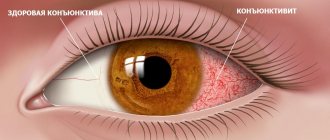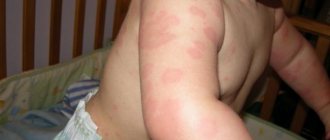Causes
Nasal congestion in newborns is caused by imperfections in the anatomical structures and functioning mechanisms of the upper respiratory tract. Single-celled glands of the mucous membrane periodically show hyperactivity, producing excess secretions. Due to the narrowness of the nasal canals, mucus is subject to stagnation and thickening. This is why babies often have a stuffy nose. Physiological swelling of the nasopharynx is also observed during teething from 6 months of age.
At the same time, pathological factors can become the cause of hypersecretion and swelling of the soft tissues of the nose:
- viral and bacterial infections;
- allergic reactions;
- injuries or congenital defects of the nose (deviated septum, choanal atresia);
- polyps in the paranasal sinuses;
- hypertrophy of the nasopharyngeal tonsil (adenoids).
Symptoms
Obstruction of the nasal canals negatively affects the quality of life of the baby - the sucking reflex is disrupted, dyspepsia occurs, tearfulness and sleep problems are noted. Let's consider the main forms of nasal breathing disorder in an infant and the accompanying symptoms.
Physiological rhinitis
Until about 3 months of age, one of the main causes of nasal congestion in a baby is a physiological runny nose. Its symptoms:
- Moderate amount of clear secretion in the nasal canals.
- The so-called “grunting” nasal breathing.
- No fever or intoxication.
- There are no signs of conjunctivitis, hyperemia or swelling of the nasopharynx.
Problems with nasal breathing in the morning are often caused by insufficient air humidity in the room. To optimize the microclimate, humidifying devices are used or wet towels are placed near the child's seat. Normalization of breathing during the day indicates that the main problem was dry air.
If a baby's nose gets stuffy at night, then, as a rule, this indicates hypersecretion of the nasal mucosa. In addition to difficulty with nasal breathing, the exudate, going down the respiratory tract, provokes a dry cough.
Obstruction of the nasal passages makes breastfeeding difficult, so the baby refuses to eat, sleeps poorly and cries often. The absence of nasal breathing in an infant for a week is assessed as constant nasal congestion and requires specialist intervention.
Allergic reactions
Due to the immaturity of the immune system, allergic manifestations are much more common in infants than in adults. With allergic edema of the upper respiratory tract, an infant has a stuffy nose, copious discharge of clear mucus, dry cough, lacrimation, and conjunctival hyperemia.
Allergens most often include household microscopic mites, plant pollen, pet hair, household chemicals, and children's hygiene items.
Infection
Due to the lack of adaptive immunity, the infant is especially susceptible to respiratory diseases of a viral and bacterial nature. ARVI causes swelling and hyperemia of the nasopharynx, the nasal canals are filled with clear or whitish mucus, body temperature is 37.3-38⁰C, the baby often grunts through his nose, and a cough is often noted. Thickening of the mucus and the appearance of pus in it indicates a bacterial infection, the temperature rises above 38°C, and signs of intoxication are evident.
Adenoids and polyps
Hypertrophy of the nasopharyngeal tonsil occurs after suffering from colds, measles, sore throat, scarlet fever. An enlarged tonsil (adenoids) can cause nasal congestion in a baby from 2 months. Associated symptoms in this case will be decreased hearing, profuse nasal discharge, sleep disturbance, and tearfulness. The lack of competent treatment at the first signs of adenoiditis is fraught with chronic nasal congestion in the future.
Polyps, which are formed as a result of the growth of the nasal mucosa, interfere with the passage of a stream of air, sometimes block the mouths of the sinuses, which leads to the development of sinusitis.
Nasal congestion without runny nose
In some cases, swelling of the nasopharynx is not accompanied by rhinorrhea. Many experts attribute this to the dry air that the baby has to breathe. In addition, dry mucous membranes may occur in the following cases:
- when a foreign body enters the nasal cavity;
- at an early stage of viral diseases;
- when baby teeth are cutting;
- as a side effect of taking certain medications;
- with a deviated nasal septum and other nasal defects.
Some forms of allergies, sinusitis, and polyposis can occur without a runny nose.
Why does a baby have a stuffy nose?
A runny nose without snot in a baby occurs for several reasons. Here are some of them.
- The indoor air is too dry. With insufficient air humidity, microcracks appear on the nasopharyngeal mucosa, so it can no longer fully perform the barrier function and protect the growing organism from microbes. The problem most often occurs in the autumn-winter period, when central heating devices are operating.
- Allergic reaction. When introducing complementary foods, nasal congestion may result in food allergies, as well as reactions to house dust.
- Entry of a foreign body into the nasal cavity. The baby can accidentally inhale a piece of food or any small object, so it is important for the mother to be especially attentive while playing and feeding.
- Deformation of the nasal septum. A congenital pathology in which one of the nasal passages becomes narrower. Swelling develops faster in it, so the baby suffers from a runny nose without snot.
- Polyps. They are neoplasms in the form of growths of the mucous membrane. Most often they occur in the area of the ethmoid labyrinth, middle turbinates and openings of the maxillary sinuses.
But the most common cause of nasal congestion in infants is a viral infection. Self-medication in such cases is unacceptable, so it is necessary to call a doctor at home as soon as possible and strictly follow the specialist’s instructions.
How to restore nasal breathing in a baby?
If a newborn has a stuffy nose, you need to contact a pediatrician who will conduct an examination and explain what to do to eliminate the obstruction of the nasal passages.
Cleansing the nasal cavity
In the case of physiological rhinitis, medications are not used. It is necessary to ensure evacuation of exudate using an aspirator. Before using the device, you should carefully study the instructions so as not to damage the baby’s delicate mucous membranes. A few minutes before the procedure, it is recommended to instill 2-3 drops of an isotonic solution such as Aqualor Baby. The drug will thin the mucus and soften the crusts, which will increase the effect of aspiration.
Another way to make nasal breathing easier is to rinse with cotton wool. Flagella are rolled out of cotton wool, soaked in clean water or 0.9% NaCl solution and placed in the nasal passages, after which they are removed with rotational movements along with clots of mucus.
Drug therapy
In case of respiratory diseases, the doctor prescribes gentle antibacterial, antifungal or antiviral drugs, immunostimulating agents of general and local action.
For allergic rhinitis, antihistamines are used. Vasoconstrictors will help overcome severe swelling of the mucous membrane. Application period: no more than 5-7 days.
Medicines for the treatment of nasal congestion in infants should be in the form of suspensions, rectal suppositories and nasal drops. You cannot independently choose a drug for a baby, much less use pharmacological agents for adults.
Application of Aqualor solutions
The Aqualor Baby series is intended for newborns in the form of drops and a spray with a “soft shower” spray. Children's preparations are sea water of isotonic concentration, which are used both for daily hygiene and as part of complex therapy for inflammatory diseases of the nasopharynx of any etiology.
Aqualor ensures softening of crusts and dissolution of mucous clots in the baby’s nasal cavity. Additional microelement composition helps stimulate local immune mechanisms, increases the resistance of the nasal mucosa to viruses, bacteria and allergens.
After 6 months, you can use other isotonic solutions of Aqualor. All brand products are created by processing natural sea water and do not include artificial additives, so they can be used to relieve nasal congestion during pregnancy, nursing mothers and those suffering from allergies.
How to drip your nose?
For babies under 6 months, special drops based on sea water are sold; you can also use saline solution, dripping 2 drops from a pipette into each nasal passage. Then you need to take an aspirator and clear the nasopharynx of mucus.
Among the preparations based on sea water, the following are popular: Aquamaris, Humer, Salin, Aqualor. You can prepare a decoction of chamomile and sage and drop it into your nose from a pipette; such remedies not only thin out the mucus, but also have an anti-inflammatory effect on the irritated mucous membrane.
Pediatricians often prescribe Ectericide to young patients; the drug is an oily liquid that effectively combats dryness of the nasal mucosa and also has a disinfectant effect on it. Ectericide is used in the following way: drop 2-3 drops into each nasal passage no more than once every two hours.
Saline solutions
- "Aqua Maris" (analogue - "Humer"). Sterilized sea water, which can be used to moisturize the nasal passages from the first days of a child’s life, as well as to combat runny nose of various etiologies;
- "Saline." A saline solution with additional chemical components (benzyl alcohol, etc.), which makes breathing easier and clears crusts from the nose.
Vasoconstrictors
- "Nazol baby"
. A remedy that was specially developed for infants and is prescribed in cases where a runny nose causes great discomfort to the baby (interferes with normal sleep or feeding); - "Nazivin"
. A children's analogue of an adult drug, containing a minimal amount of active substance, as well as a number of chemical components that can negatively affect the health and well-being of the baby. For this reason, it is recommended to be used only as an emergency remedy; - "Otrivin"
. Another common vasoconstrictor drug that has a number of side effects and can also be addictive.
When treating a runny nose in children under six months of age, vasoconstrictor drugs should not be used more than 2 times a day or for more than 3 days in a row.
Enveloping and cauterizing drugs
"Protargol". The main component of the product is silver ions, so the drops are effective against all types of rhinitis, including purulent and bacterial (the drug is not used for runny noses of viral etiology). Incorrect and too long-term use of drops can cause the accumulation of silver in the body, which will lead to negative consequences.
Antiallergic drugs
An effective remedy for combating allergic rhinitis, however, before using drops, you should make sure that the diagnosis is correct.
Preventive measures
To make it easier for your baby to breathe through the nose and increase resistance to respiratory infections, you should:
- Regularly ventilate the room, perform wet cleaning, and ensure air humidification up to 60-70%.
- Get rid of “dust collectors” - carpets, woolen rugs and blankets, soft toys, down pillows.
- Avoid contact with pets.
- Regularly, morning and evening, perform nasal hygiene by instilling 2-3 drops of the isotonic drug Aqualor Baby into each nostril.










